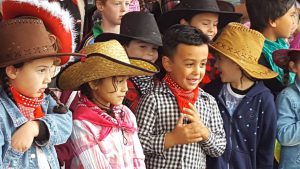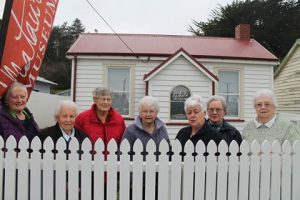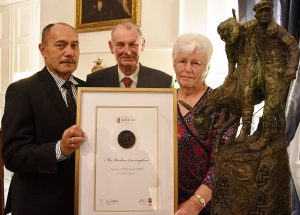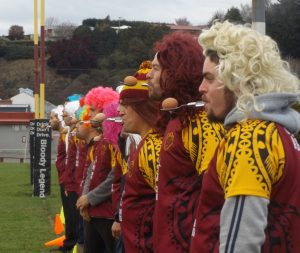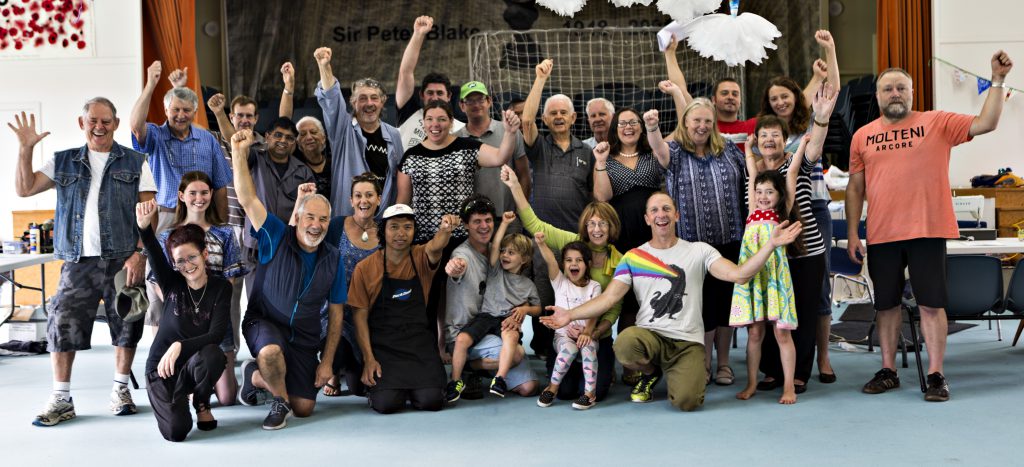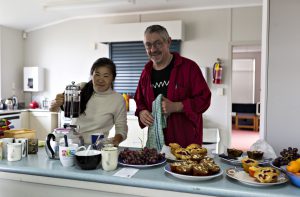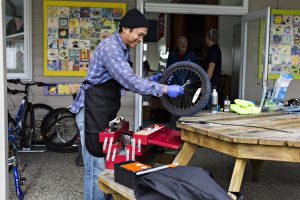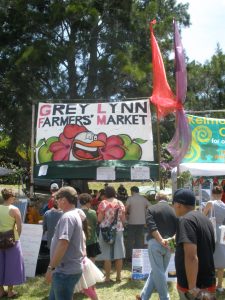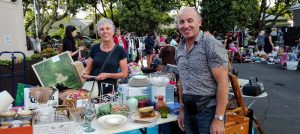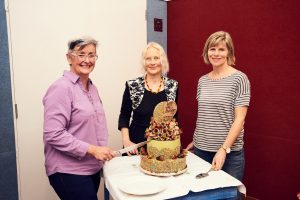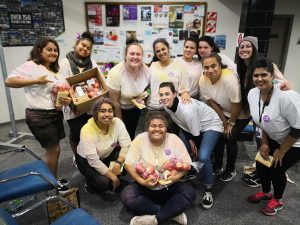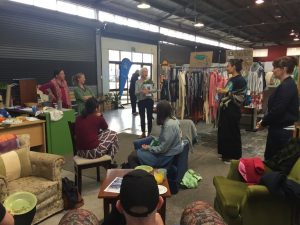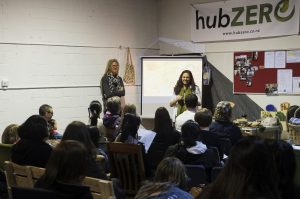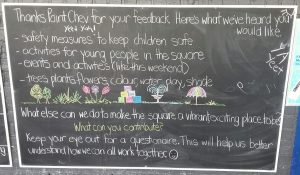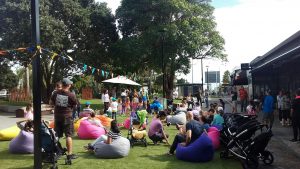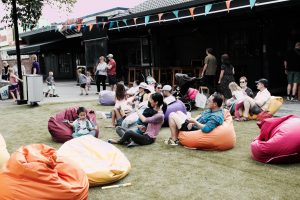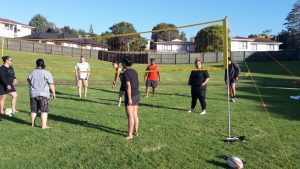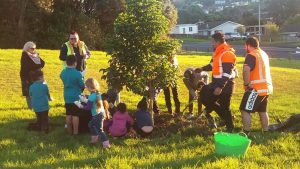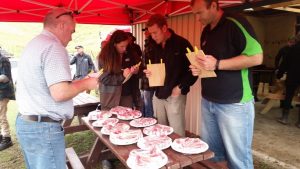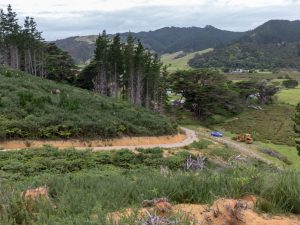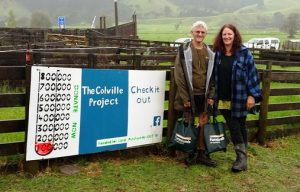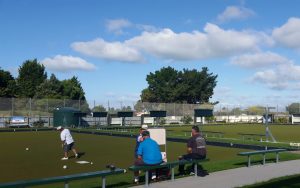Mataura: a community transformed
Jo Brand, former Community Development Worker, says Mataura was “limping along and disconnected”. This was partly due to the shut-down of various industries over the years, resulting in people moving away to find work and to access a better range of facilities. A lot of property was owned by absentee owners and wasn’t looked after well. Jo adds says that “all the numbers were terrible”, according to a 2008 study done by Public Health South (Southern District Health Board). Mataura also had the lowest decile school in Southland, only one out of five kids were school ready at age 5 and the crime statistics were less than ideal.
Shared local visions drive action and change
Government agencies were concerned about Mataura and were going to meet to decide what to do, but then they realised that the locals were already creating a way forward. The town had already formed a taskforce and started working with Inspiring Communities.
Alan Taylor, Chair of the Community Board, stresses that “there is always a need for a common vision”. So, the process started with a community consultation workshop. Everyone got together to talk about what they wanted in Mataura. “We started with celebrating and identifying who Mataura is first. That we’re not buying into what everyone else was telling us we were or weren’t” says Jo.
The residents created lists of what they wanted to see in the town and 70% of the projects on those lists have now been completed, even ones Jo never thought would succeed. Having more than one cafe in a town of 1,500 people didn’t seem realistic, but they now have two independent cafes as well as a Four Square and a fish and chip shop.
Using existing strengths and assets
Jo believes “the skillset was always there from the people. It just needed encouragement”. Many of the town’s projects have been ones of restoration. The Mataura Museum was a struggling entity until a group of volunteers worked with Gore District Council to restore the building. They made it interactive and modern, relevant and local. On opening, in 2015, it won Best Museum Project Award at the NZ Museum Awards and one of the volunteers travelled to a Heritage conference in Croatia to speak about the project.
The old town hall was restored and there is also a newer community centre, which is a real focal point for the community.
Eleanor Ranstead, the current Community Development Coordinator, has witnessed the extraordinary transformation of the town in her 20 or so years in the area: “It has a lot of hope”. She says the focus is now on building the capacity of community groups and people. The list of programmes, activities and resources the town now offers is extensive: a Mens’ Shed, Strengthening Families, community lunches, Toddler Time, the Bunker Youth Centre, Mind Matters, an Al-Anon group and a suicide prevention group, activities at four different churches and so much more.
“What’s really emerged is not so much leaders. It’s that people have embraced other people’s strengths. People recognise and understand that you don’t have to be the expert at everything. But everybody has an expertise in something. That’s what we do differently now” says Jo.
Many people, groups and sectors working together
Mataura was awarded a Community Development Scheme grant by the Department of Internal Affairs. The community has also worked with Inspiring Communities on a regular basis and has brought Jim Diers to town to do workshops on several occasions. Gore District Council has been another important partner in the town’s development.
Working collaboratively is something that the town’s people have got better at over time. “Now we say ‘Here’s what we want to do. Who do we need to help us get that?’” says Jo. “To encourage involvement from the community is huge. And working with local government is important” adds Alan.
Working adaptively, learning informs planning and action
There has been a lot of learning along the way. “It was a journey of understanding what people needed” Jo says. “The community gardens didn’t work at first. They realised they had to charge money because no-one would come if it was free”.
Barbara Cunningham is responsible for the community gardens. The project expanded further when she realised that the Meals on Wheels programme was using frozen meals from Gore. She took over the contract and started delivering fresh food, using produce from the garden. The service now runs five days a week.
Other projects include demolishing derelict buildings and putting in parks and recreation areas, building a sensory garden and an outdoor gym circuit and creating a new childcare centre which fits the needs of the local parents, many of whom do shift work. The primary school roll is up by about 30 and they’ve just established a bilingual class.
Mataura Marae sat incomplete for about 30 years, after a number of setbacks prevented renovations taking place. Work finally restarted in 2017. The wharenui is now finished and the plan is to have gardens and possibly a café, with wheelchair accessibility and a family friendly atmosphere.
These projects are not only important to Mataura. Gore District Council wants to retain Mataura as a destination point, so Southlanders (and others) stop and visit.
The population is on the rise and house prices are increasing, but are still affordable, which makes it a very attractive location. And business is booming! Eleanor estimates that there are now 80 – 100 businesses operating in the town. The townspeople think local before buying further afield and some businesses that might have closed down have been bought and run by other locals.
Jo captures Mataura’s community spirit well when she says “I remember my Great Grandmother telling us ‘just do what you can to help others: it doesn’t matter if it seems small to you’. I think that sort of sums up why Mataura is what it is”.
My Inspiring Community: Randwick Park
With a shared local vision to drive and create change, the people of Manurewa (Community of the Year 2017) utilised their existing strengths to better understand what their young people needed in order to feel connected – working together across the sector and community groups and whanau to deliver to their shared vision for the outcome.
Community-Led Development Principles
Using existing strengths and assets
Shared local visions drive action and change
Learning by doing
Visit their website to learn more here: Randwick Park: Manu Tukutuku
A positive Christchurch community story
Riccarton West used to be a place where “people didn’t meet people… there wasn’t a sense of belonging”, according to one local. After a series of community-led projects in the area, crime stats are down, residents are more connected and people are caring for the environment and the community. Take a look at their awesome video below and if you’d like more information about this initiative, check out Oak Development Trust’s website. Riccarton West Community Documentary from Dan Watson on Vimeo. It’s also been reposted on our YouTube channel here.
Connecting communities one repair at a time
Nowadays the need for a circular economy is a statement that’s hot on everyone’s lips. A perfect example of an initiative that meets this need is the Repair Café movement. Repair Cafés seem to be popping up everywhere! In fact, there are over 1,500 Repair Cafés worldwide. The first one was in The Netherlands in 2009 and now they are happening in Aotearoa too: in Christchurch, Kapiti Coast, Te Puke, Auckland…
So what is a Repair Café? It’s a pop-up event where people can bring items to be repaired instead of throwing them away. The event is run by volunteers who have repair skills to teach or to share. Depending on the expertise of the volunteers, repairs can be made to machinery, bikes, clothing, toys, furniture, electrical appliances and more. The purpose of these events is two-fold: to try to change our “throwaway culture” and to bring people in the community together. An added bonus is that it saves people money: if their item can be repaired they don’t need to replace it or pay for more expensive repairs elsewhere. If the item can’t be repaired, then the event organisers dispose of the item. It’s a win-win!
Work with diverse people and sectors
Steve McLuckie is the coordinator for Shore to Thrive, a strengths-based, community-led partnership project between Auckland North Community and Development (ANCAD) and the Takapuna Methodist Church. Steve explains that Shore to Thrive “is all about bringing people together, fermenting locally led change and positive outcomes in partnership with local people. It is about supporting community connections and strengthening relationships to enhance the wellbeing of families and children in North Shore Communities”.
Shore to Thrive partnered with Global Action Plan Oceania and the Devonport Community Recycling Centre team to organise their first Repair Café event in 2016 in Bayswater. Steve says that they thought this local opportunity would fit their strengths-based and community-led kaupapa. They had heard about similar events being held overseas and the first one in Aotearoa had taken place in Pt Chevalier (Auckland) earlier that year. Steve explains that they decided to run a Repair Café because they bring people together to share skills, save money and reduce the amount of waste going to landfill. And, of course, there’s always food! “It’s a beautiful idea that ticks a whole lot of different boxes”.
This first event provided the catalyst for a successful, collaborative application to Auckland Council’s Waste Minimisation and Innovation Fund that has allowed the partnership to grow the Repair Café movement across Auckland. In 18 months, they supported 18 events and saved people around $60,000 on replacement costs!
Build from strengths
The key to the success of a Repair Café event is finding skilled and passionate volunteers. The volunteers not only need to have repair skills, but they need to buy-in to the idea and be able to engage with the community. The team managed to recruit local volunteer experts in a variety of areas: electrical appliance repair, clothes repair, woodwork, bike repair and more. All of them were engaged and excited to be participating. Often these events can see people come out of the woodwork and use skills that had been lying dormant. Volunteers can not only help the community by using their skills, they can also teach these skills to others.
Learn by doing
Glenys Chapman, who started volunteering at some of the events by doing mending, says she participates because she enjoys “being able to recycle things, talk to people, the community feel, the shared food: the whole idea gels with me”. Mostly she repairs, rather than teaching repair, but “sometimes people learn how to sew on a button, for example. I try to talk about what I’m doing so that the person might learn the skill themselves, but not everyone has a sewing machine”.
Tasha Wehrle, who attended an event and then decided to volunteer at Repair Cafés, says “for the people who attend the benefits are huge, as it saves people time, money and having to drive out of the area to get something fixed. It brings people together, they connect and it strengthens knowledge, friendship and community spirit. The same benefits apply for volunteers but with the added bonus of feeling useful and using their skills”.
What’s next?
Soon after we did this interview, the Repair Auckland partnership won an Auckland Community Zero Waste Award in the following category POWER OF THE PEOPLE – For a group, community organisation (not for profit) or school that has demonstrated commitment, effort and leadership. There are already nine Repair Café events scheduled for 2019, with the prospect of many more. These include the first of the year at Browns Bay on the 17th of February.
If you’d like to learn more about how to run an event in your area, check out the Repair Café Auckland website, where you can find an event “how to” guide. They can also support you to plan and host a local Repair Café at your community facility or attend one at another site. And if you’re in the Auckland area, you can hire a trailer full of tools for your event!
Here’s a look at the 2017 Bayswater event in an excerpt from the film Living the Change.
And here’s another Repair Café event at the Gribblehurst Hub in Auckland.
Grey Lynn 2030’s transformation over the last decade
Like Inspiring Communities, Grey Lynn 2030 is celebrating its 10 year anniversary this year (2018)! We spoke to Brigitte Sistig and Colinda Rowe about how the organisation started, what it focuses on and where it’s headed.
Grow from shared local visions
Grey Lynn 2030 started out as a couple of locals talking about what they could do to support a healthy local environment and community. At a public meeting in 2008, the Grey Lynn community created a vision of how their neighbourhood could look if it was more self-sustaining, relied less on fossil fuels and imported goods, and created less pollution.
The community wanted a local market, greater biodiversity, safer streets, community gardens, local waterway restoration and to know their neighbours. So they drew up a plan and Grey Lynn 2030 was born!
Grey Lynn 2030 (GL2030) is part of the Transition Towns movement, which is about communities coming together to address big challenges by starting local. The movement has a major environmental focus, and this is evident in everything GL2030 does.
Brigitte Sistig, the Chair, explains that being a Transition Town means that “any initiatives and solutions come from the community”. To achieve the community’s vision, they set up several focus groups around waste, energy, urban environment and more. Out of these groups have come many interesting and popular initiatives. In 2009, the first major project was an E-waste Action day. Over 12 tonnes of computer equipment was collected and diverted from landfill.
Also in 2009, a Farmer’s Market was established and has steadily grown in popularity over the last decade. The market has a strong commitment to becoming zero waste. Workshops are frequently offered during market hours, which provide an opportunity for GL2030 to share ways of getting involved at a local level. GL2030 also launched a website and a monthly newsletter to further spread the word.
Other projects in which local people have become involved include community gardens, fruit tree planting, traffic calming, berm bombs, the community choir, Repair Cafés, car boot markets and starting up a Business Association in 2010.
Brigitte finds it rewarding to see things changing in the community. “To see the community coming together at the Farmer’s Market every Sunday morning is inspiring. People can learn where their food comes from and connect with friends. It’s a real community place”.
Colinda Rowe, who moved into the area in 2009, became involved with GL2030 as she wanted to “get connected” to the neighbourhood. She became a Trustee in 2012, was Chair for four years and is now the Treasurer. “I’ve met some wonderful like-minded people who are now good friends and I love being able to go to local places such as the Farmers Market to catch up with them – it makes me feel like I live in a village within a city”.
Work with diverse people and sectors
GL2030 is a great example of using collaboration to help achieve your vision. “Often, with grassroots initiatives, when people have a good idea they are ready for action, but sometimes there can be a time delay, due to the processes Council needs to go through” says Brigitte. “In this situation, it’s important to keep the vision, the interest and the group’s energy going.”
In 2015, GL2030 worked with the Earth Action Trust to secure funding from Auckland Council’s Waste Minimisation and Innovation Fund to set up a one-year trial Resource Recovery Centre, which opened in 2017. During that year, the RePurpose Community Recycling Centre diverted 10.8 tonnes of waste from landfill.
GL2030 holds Green Screens film nights which involve inviting a local speaker along, watching an environmentally-themed movie and discussing it afterwards. Brigitte has found that these sessions are “a real catalyst for action”.
The Grey Lynn Business Association has brought together diverse enterprises from all over the neighbourhood, including ethical businesses and people who work from home. “Sustainability has been emphasised from the very beginning in the Grey Lynn Business Association” adds Brigitte.
Earlier this year, GL2030 held its first Trash to Trade competition showcase, in collaboration with Waitematā Local Board and the Grey Lynn and Kingsland Business Associations. Brigitte explains “Local businesses offered up their business waste, in keeping with sustainable business commitment, supporting emerging up-cycling artisans to create new works. The event attracted fantastic upcycled entries and stimulating conversation between artistic makers and experienced business managers. Listening to the stories of the makers was a highlight of the event.” This project has strong support and will continue next year.
Learn by doing
“It’s a continuous learning process” says Colinda. Grey Lynn 2030 “has enabled people in our community to action their ideas by providing a place of incubation and support for initiatives as well as a legal structure to allow for funding to be requested for these projects” she explains.
So what does the future hold?
GL2030 has plans to revive and reconnect some of the groups that have gone in different directions. Specifically, they want to focus on finding local solutions to the energy crisis and are aiming to continue with local food production with their Food Forest project. There are also plans for a more permanent Resource Recovery Centre in Western Springs and more local upcycling initiatives.
There aren’t as many Transition Towns now, but Brigitte thinks there could be a revival on the horizon. “People are noticing that climate change is real. I have a sense that there’s a new movement and more people will want to become involved. People are realising that it actually takes personal change as well”.
Colinda says this is just what they need. People power! She talks about how vitally important it is to have a good volunteer base. She strongly recommends that other communities start Transition Towns in their area because “meeting new people and growing new friendships whilst doing something positive for your neighbourhood and our planet is extremely rewarding”.
______
Grey Lynn 2030 has published a book about their journey over the last decade. You can order a copy here.
To find out more about Grey Lynn 2030, go to their website.
Learn more about their Trash to Trade project by watching the following awesome video.
The Trash to Trade Competition
For more about Transition Towns, see http://www.transitiontowns.org.nz/.
Building sustainable change in Auckland
When community development worker Tara Moala walks away from a project, she has to be confident it will be owned by the community and will remain in the community.
These outcomes are embedded in the way she and her colleagues at Rākau Tautoko support the development and growth of community.
Rākau Tautoko is a small, Auckland-based consulting social enterprise undertaking community-related projects, community research and development advice, facilitation and leadership. It creates supportive opportunities for community practitioners to develop their knowledge and skills, apply their philosophy and exercise appropriate accountabilities.
Grow from shared local visions
Tara’s latest involvement is with the Hub Zero project in Panmure. Funding for this project came from came from the Maungakiekie-Tāmaki Local Board and was originally allocated towards investigating the development of a single social enterprise, but a strong community voice had other ideas.
The result was Hub Zero, which is a centre where many waste-based social enterprises are supported to grow. It helps small businesses to prevent waste from ending up in landfill and to create new, upcycled products for sale.
At Hub Zero you will find:
- permanent and hot desk spaces for small social enterprises to base themselves
- a shop full of upcycled products made by local entrepreneurs
- a space for connection and networking
- office space for Hub Zero partners and friends
- a workshop room that can be hired out for community meetings and waste reduction workshops.
“There were a lot of ideas around creating a platform to do things better, so we shifted our mind-set to allow everyone to flourish” Tara says.
“That end game is what it’s all about,” she explains. “A key question to ask is ‘How will things keep going once we step back?’. If the answer is from outside funding and expertise, then it is not sustainable. It’s not going to work”.
Build from strengths
Using the founding principles from the Tamaki Inclusive Engagement Strategy (TIES), Tara believes the success of community-led development (CLD) lies in the way funders, groups, social services and anyone working with a community listens to what the community is asking for and involves community from the start.
Tara’s top three ways of working are:
- involve community in all the decisions
- ensure every single project can stand alone financially and be sustainable
- make sure the community wants to do it
Tara explains that they use the TIES foundation principles and guidelines in every project, to ensure that the community is valued. “We never hold the project; the community does. We might support it for a bit of time, but it is always returned to the community. When we walk away it remains in the community and is owned by the community.”
Tara acknowledges this is easier said than done. Often funding drives community ambition and outcomes, and there is no clear guideline on how to achieve sustainable and ongoing financial support. Communities are complex and unique so what works for one might not work for another.
“There are proven experiences for what works in Tamaki and these go back to CLD,” Tara says. “How to create community ownership is a skill and one all social services need to work on.”
Community at the heart for Point Chevalier
Project Background
In 2017 the Albert Eden Local Board allocated funding for “the coordination and activation of a placemaking initiative in Pt. Chevalier focused on the town centre”. The aim was to revitalise the Point Chevalier town centre into a vibrant and inclusive space.
Some challenges like poor town planning, local building expansion and development and reduced community policing were historic. Others, like poor media portrayal of the town centre and issues with social behaviour and rough sleeping, were just emerging.
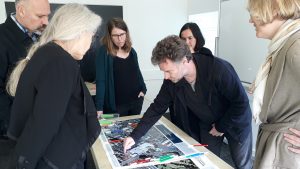 Finn Mackesy is no stranger to the Point Chevalier community, having co-founded Transition Point Chevalier and co-coordinated the Point Chevalier Treasure Hunt a decade ago. He also works at Resilio Studio. As well as landscape, urbanism and architectural design, Resilio’s focus is on social innovation, education and facilitation. They support a range of projects in Tāmaki Makaurau, from public open space development to curriculum development, placemaking, social labs and community empowerment. Finn and his team are driven by the desire to support Auckland communities and focused on solutions that encompass positive and transformative change. They wanted to be part of this project so they took on the role of coordinating and facilitating a co-design process with other stakeholders in the community.
Finn Mackesy is no stranger to the Point Chevalier community, having co-founded Transition Point Chevalier and co-coordinated the Point Chevalier Treasure Hunt a decade ago. He also works at Resilio Studio. As well as landscape, urbanism and architectural design, Resilio’s focus is on social innovation, education and facilitation. They support a range of projects in Tāmaki Makaurau, from public open space development to curriculum development, placemaking, social labs and community empowerment. Finn and his team are driven by the desire to support Auckland communities and focused on solutions that encompass positive and transformative change. They wanted to be part of this project so they took on the role of coordinating and facilitating a co-design process with other stakeholders in the community.
Work with diverse people and sectors
A key characteristic of CLD is working with a diverse range of community stakeholders, so the project team intentionally included local council staff along with local organisations, businesses and residents in their core group.
“The ideal situation is to collectively define what the problem is and the challenges you are taking on. Then you are sharing the work in terms of trying to understand and analyse those problems and collectively generate solutions” explains Finn.
In total there were more than 10 project partners and 15 additional groups engaged in the process, including Auckland Council, Pt. Chevalier Social Enterprise Trust, Transition Pt. Chevalier, Pt. Chevalier RSA, Nomad, Learning at the Point Community Kindergarten, Auckland Transport and local residents.
Resilio Studio and its Placemaking Project partners spent several months researching, networking, observing and mapping the area. They started by “focusing on the known issues, impacts and concerns” and went from there. Their purpose was to “work together to improve the experience of living, working and playing in and around the town centre”. The second stage of the project is to focus on the activation of the local square and working to improve connectivity and safety in the town centre.
Building diverse and collaborative local leadership
Throughout the process there were ongoing opportunities for the project group to meet with influencers and decision makers whose work impacted on and continues to influence Point Chevalier.
Finn says a significant highlight was witnessing “the placemaking group becoming the local experts on local matters and having influencers and decision makers coming to them for information, insights and perspective”.
Community-led development has informed Resilio Studio’s business practice since they began three years ago. Inspiring Communities has provided a source of inspiration and models of good CLD practice which continue to shape the way it works and the way the Point Chevalier Placemaking Project operates.
Learn by doing
It can be difficult in this type of project to translate outcomes into numbers. Many changes will be gradual, rolling out over a 10 year period, but will be influenced by decisions made in the immediate and short term.
At the beginning of the project, few people seemed to “appreciate the scale of change happening in and around the town centre”, according to Finn. However, as community engagement progressed, a shift in focus occurred from “trying to improve existing public spaces to influencing and helping the community to shape coming changes to best serve the community”.
You can find more about this awesome project here.
Sustainable change through leadership
Sport Waitakere’s purpose is simple – to make a positive impact on West Auckland residents and their lives through sport and recreation. Since 1991, Sport Waitakere has been working within the boundaries of Auckland Council’s three local boards: Whau, Waitakere Ranges and Henderson/Massey. It’s a diverse and complex environment to manage, especially given that at any one time they can have more than 60 projects on the go.
Sport Waitakere has recently learned and implemented some valuable lessons that have helped them to be more sustainable.
Grow from shared local visions
When Sport Waitakere community broker Antonia Vai took it upon herself to do things a little differently in the Waitakere Ranges Local Board area, things quickly started to change.
Jasmine Graham, from Sport Waitakere, explains: “Antonia was quick to understand the importance of bringing local organisations together to support the opportunities within that community, allowing the people of that community to be the experts and providing a platform for local champions to thrive”.
As an example, Sunvue Park in Glen Eden was equipped with a basketball hoop and playground equipment. However, not many people were using the park, so Antonia decided to find out why. By mapping what was already happening in the area and engaging locals, it was quickly established that a volleyball net would have been a better investment. Through her ongoing networking with other agencies in the area, Antonia found out that a local community hub was getting rid of a volleyball net. It was an easy fix.
Lack of shade also impacted on use of the space during the warmer months. After a few meetings with Auckland Council and Waitakere Ranges Local Board and with the support of Healthy Families Waitakere, more trees were soon planted.
A relationship with Inspiring Communities was already underway which helped Sport Waitakere to understand a community-led development approach. Furthermore, once an understanding of this level of community engagement was put into action, Sport Waitakere started to evolve all its operations to a more community friendly approach.
“What Antonia did was pretty special,” Jasmine says. “By getting back to the basics and simply asking the community what they wanted in their park we realised the assumptions on the way spaces were being used were not entirely true”.
Learn by doing
Jasmine says the very first value of Sport Waitakere was “lead from the front” which resulted in engagement with and providing solutions for the community. She says “we’d offer advice, expertise and leadership to our community” which was well intentioned, but didn’t work so well in terms of having a “sustainable impact within our community”.
Better-used park spaces and greater care of the environment were some of the results from this new way of working. This quickly attracted attention from local board funders and changes were made to the Community Broker contracts to reflect this way of working.
“As community brokers, we are now given freedom to work in a community development framework,” Jasmine explains. “We can have open dialogue with local communities, groups and residents on how they use spaces for activities and how we can better support that. It opens up more opportunities to collaborate with existing groups on what is already happening and what’s working”.
Grow collaborative local leadership
This has also resulted in changes to Sport Waitakere’s value statements. “We lead from the front” has been amended to “We build leaders”. Leadership needed to happen from within the community by Sport Waitakere working with the community instead of for them.
Jasmine says the changes from inside and outside the organisation are a lot more sustainable compared to how things have been in the past and that changing from “an asset-based perspective” to one of “championing local leaders” drives a greater change within the community.
Work with diverse people and sectors
Support for implementing these changes has come from many groups, including Inspiring Communities. Jasmine says the organisation still has “much to learn and improve on” and is looking forward to ongoing support as the journey continues.
Colville building a healthier rural community
Picturesque Colville sits near the top of the Coromandel Peninsula. Located 26km north of Coromandel town, it’s located within the Northern Coromandel: a rural, remote region with a small community of around 700 residents, except in the peak of the tourist season, when the population swells to over 10,000 people. The emergent issue facing the town and the wider area is a lack of infrastructure to support not only the seasonal tourist population, but also the community in general, which has to travel out of Colville for many essential services. The Colville Project is an attempt to address these issues with the provision of an all-in-one community and health centre that would deliver much needed services from one central location. The vision is that this project and the centre will regenerate the community, making it a much better place to live and encouraging people to stay in the area.
The Challenges and the Response
Bronwyn Blair, the project spokesperson, has lived in the area for over 20 years. She explains the challenges the area faces.
- Healthcare: The current health clinic has no running water in its consultation rooms and limited space. Minor surgeries and other procedures are done in a portable sterile room outside the clinic so that people don’t have to travel up to four hours’ return to Thames Hospital.
- Employment: Many people have to move away to start a career or find full-time work.
- Education: Anyone needing ongoing education and training needs to look elsewhere. The primary school population isn’t stable which impacts on both current and future student populations and the community as a whole.
- An aging population: There are very few rental properties for people moving into the area. It’s a popular place for retirement but doesn’t have the infrastructure to support more retirees.
The Colville Project (TCP), which is run as a community partnership between the Colville Community Health Trust (CCHT) and Colville Social Service Collective (CSSC), is ambitious; it’s all about the regeneration and sustainability of the community.
Bronwyn summarises: “We want to create an opportunity for a health and well-being based industry that will contribute to the sustainability of rural practices across the country, and support holistic well-being, including training, in integrated practice. This will contribute nationally and regionally, and bring employment locally”. For that to happen, there have to be facilities that deliver the services needed by the community. This is what the new health and community centre would provide.
There are four parts to the project. Stage One is the well-being and education centre; Stage Two is Staff and Student Accommodation; Stage Three is to build affordable housing and support for families and older people; and Stage Four is to create youth recreation and training opportunities.
Shared local visions drive action and change
Bronwyn, who is also the Chair of the CSSC, says both organisations wanted a healthy and thriving rural community. “But we wanted to think more broadly than health”. They wanted to reach as many people in the wider community as possible. They came up with a shared vision, then a proposal that they took to the community in the form of consultation workshops. They took a slightly different approach with their consultation. Bronwyn explains that “instead of having one central workshop which would mean people having to travel significant distances, we held workshops in four different areas within the Northern Coromandel region”. They gathered feedback, answered questions and examined the communities’ aspirations. They had around 130 people attend across the region. Bronwyn says this was really effective as they found that the demographics were different in different areas and they couldn’t have captured as much information in just one workshop.
“It was very clear that over 90% of the population wanted this project for the community, which was a good driver to go ahead. What was proposed is actually what we want. To see complete alignment in that was really wonderful” says Bronwyn.
As well as community consultation, research was undertaken, including an independent feasibility study which found that the project would be of significant benefit to the community and a great support for it.
Using existing strengths and assets
The first step is to purchase land. A 32 hectare piece of land has been identified as suitable and the project team is now fundraising to buy it. At first, they thought that putting different facilities in different locations would best serve the wider community. However, after consultation, it was found that the community wanted all of the services to be in one, central location. Bronwyn believes strongly that the community needs to have ownership of the land. “Many fundraising opportunities are now being driven by the community, with the Project Team just keeping the ball rolling”.
Many people, groups and sectors working together
However, the 700 permanent residents of the Northern Coromandel cannot do this alone. The plan is to reach out to the wider community who visit, live, work and play in the Coromandel, and individuals and groups across New Zealand who share similar aspirations for the area.
Community Waikato helped them with their strategic plan and they secured some external funding from the Department of Internal Affairs who awarded CSSC a three year Community Development Scheme grant. This allowed them to hire two community development workers to support several community development projects, TCP being one of them.
In addition to this, the Project Team has launched a fundraising drive, which included not only asking for charitable donations through their website, but also running community-led campaigns and events such as the Great Lamb Chop Competition, the Colville Dine and Dance event, Papa Aroha community dinners, fruit sales by community members with surplus produce, the 100 Hippies Campaign and The Colville Family Reunion – an evening of Colville-connected bands playing at The Thirsty Dog in Auckland.
“Our community has given around $170,000 towards Stage One, the Wellbeing and Education Centre” says Bronwyn. “The local community is totally behind the project”.
The project has raised around 28% of the funds needed for the purchase of the land.
Working adaptively, learning informs planning and action
The team is now setting up a third trust: the Colville Project Trust. Bronwyn says it’s really important to take time to get the right trustees and to set the trust up for success. She adds that “it has always been part of our vision. It has been a massive undertaking, a massive learning curve”. She stresses the importance of keeping careful records of your processes and also recording positive experiences and learnings as you go. Bronwyn says they want to “become a beacon for other small communities around the country if not the world. If this learning can go out further, that’s a real outcome.”
“We have to pull together to determine and make a positive future for ourselves, our kids and for all the people who live, work, play and visit so that we have the services and amenities we need for daily life – and to provide and generate opportunities to continue to live here, socialise, train and upskill and find employment so we have a productive, sustainable community, built on the principles of care for people, for the environment, for a better, kinder future”.
But they have a long way to go yet. “It’s a big vision and one we can achieve together, as a united community” says Bronwyn.
To learn more about this fantastic initiative and how you can support it, check out the TCP website and their awesome video below.
The Pūkeko Centre: A shared vision in East Christchurch
The Parklands community in East Christchurch was badly affected by the 2011 earthquakes. This is a story of how two unlikely collaborators came together to create something new for the whole community, using a community-led approach.
After the February 2011 earthquakes, both Parklands Bowling Club and Parklands Rugby Roosters club found themselves without a home. The bowling club’s greens had been ripped apart by the quakes and badly damaged by liquefaction and their pavilion was in a state beyond repair. At the same time, Parklands Roosters Rugby club changed overnight from a sports club to a “welfare club” according to the former Chair, Maurice Lawlor. The club sprang into action to support its members, who were devastated by the quakes. The earthquakes had also caused damage to the Roosters’ base and so, they were looking for a new home as well. Together, the two organisations came up with the idea of creating a new centre that both clubs could use, which could also be opened up to the wider community. This marked the start of a wonderful collaboration by the two clubs to build not only a new clubroom, but a new community centre.
Many people, groups and sectors working together
The process started with a lot of community consultation and some support from other organisations. Lawlor, now the Chair of the Pūkeko Centre Committee, says that Christchurch City Council and the local residents’ association helped the newly formed committee to identify community groups in the area who might be interested in using a new community facility and from this, networking groups were formed, made up of interested individuals, organisations and local businesses. The committee also engaged with the Burwood-Pegasus Community Board on a regular basis and have had a lot of support from Sport Canterbury. Lawlor added that they also had a trade show to which they invited all the community groups. This was an opportunity to “talk about what their needs were and to share our vision”, he says. Lawlor explains that the committee ran an independent capability study which included consulting a wide range of groups. They also engaged an external consultant, who came in to facilitate community discussions around what was needed. The community had input into the name of the centre as well. It was chosen due to the fact that female pūkeko all lay their eggs in the same nest and the eggs and chicks are then nurtured by the whole community.
Using existing strengths and assets
Building a new clubroom was going to be too expensive, so they needed to think outside the square. This resulted in two buildings at the local, closed Freeville School being identified as suitable for the project. They had previously been destined for demolition, but were then gifted to the committee by the Ministry of Education. The buildings were relocated onto the bowling club site, a new foundation was added and a compete refit carried out to turn the building into a modern multi-purpose pavilion. These are now being redeveloped into a multi-sports, recreation and community centre.
Shared local visions drive action and change
The vision was always that the centre would be more than a sports club. Lawlor says that “other groups needed a space. People needed connectivity”. He explains that the idea is that the Pūkeko centre will give community groups a home, allow them to connect, leverage off each other, reduce duplication and grow their own projects. There are a number of groups who are already using the centre and many more that want to set themselves up as regular users, such as Girl Guides, Brownies and health and fitness and senior card groups, plus a number of support networks. Parkview Primary School is located right next door and its Principal, Simon Thomas, says that the clubrooms are currently being used for socialising by the teachers and, in the not-too-distant future, school assemblies will be held at the centre once the hall is built. Parkview doesn’t currently have a big enough space for whole school assemblies, community presentations or other large school gatherings. It may be 5 – 10 years before they can afford to build their own hall so, in the meantime, they are happy to have this arrangement with the Pūkeko Centre. In addition to this, there is an agreement with Sports Canterbury which will allow the school children to start learning to bowl at the club in future. Thomas values the Pūkeko centre as it’s “community driven, has the same vision as the school and there is a great relationship and great community desire” for such a space.
After a lot of hard work, fund raising and help from sponsors, philanthropists, funding bodies and private donors, Stage 1 was completed and was opened by the Mayor of Christchurch, Lianne Dalziel, on 24th February 2018. The clubroom building features a bar, a kitchen, meeting spaces and a free community library corner with comfy couches. The space has lots of natural light and a welcoming feel. Funds still need to be raised for Stage Two, which will result in the opening of the hall (hopefully at the end of this year); Stage Three, which will see a breezeway built and the car parking area finished; and Stage Four, which completes the project with the final landscaping and outdoor court construction.
What will success look like?
The Pūkeko Centre has already achieved a lot, but they have still have so much they want to accomplish for their community. Wayne Eden, a committee member, says that “success will show when we see a vibrant and well-used complex with a reputation for its supportive and welcoming environment. Our very generous sponsors and funders will be able to take pride in the fact that they have contributed to a very valuable community asset.”
Eden concludes by saying “having met and worked with such a large number of community-minded people who have been so generous with their time, support and encouragement along our journey has been totally rewarding and makes it all worthwhile.”
If you’d like to learn more about the Pūkeko Centre, check our their awesome video!
The Pukeko Centre – Our story from Belmont on Vimeo.

